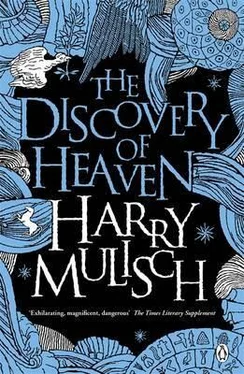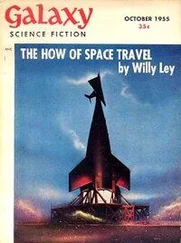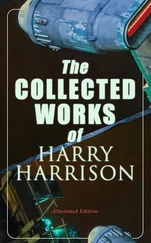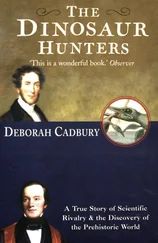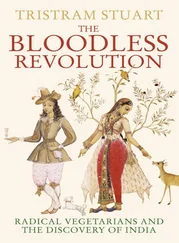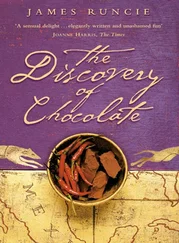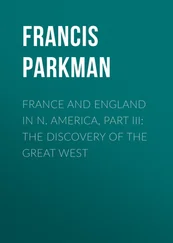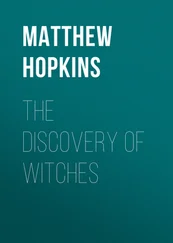Quinten pointed out to him the great icon, which stood on the altar: a triptych with opened side panels. The scene could scarcely be distinguished in the dim light, but he told his father what he had just read: the image of the most holy savior on the central panel, acheiropoeton, had been painted not by a human hand but by an angel. Only the head painted on silk had not been covered by gilded, heavily worked silver, but that head was not the original one; that was underneath. The panel was covered by a semicircular canopy, crowned by two gilded angels.
"Yes, Quinten," said Onno with a laugh. "We're not in Holland here." He put his hand on the bars. "To my taste it's more like a torture chamber here. Look at this, between those turned columns above the altar: there are also two barred windows. Of course from there the holy fathers were watched as they sat praying. And the bottom part of that altar itself is also all bars. Look at those locks."
Quinten looked at the padlocks, which he had not yet noticed. The top one was a gigantic iron thing, a sliding padlock, as large as a loaf — the moment he saw it, he was overcome by alarm. Where was he? Was he dreaming? Was he in his dream? He looked at his father with his eyes wide.
"What's wrong?" asked Onno in alarm. "You've gone as pale as a ghost."
"I don't know. ." he stammered.
Was that vanished Lateran palace his Citadel? Was he there? Those steps, four times seven steps, that chapel, his mother… In confusion, he turned away from the bars and for the moment met the glance of an old woman, who had mounted the twenty-eighth step, stood up groaning, crossed herself, smiled at him for a moment, and, rubbing one thigh, went to the other staircase.
"Let's go," said Onno. "It's unhealthy here. You have to eat something."
Quinten shook his head. "That's not why. ." He could not possibly tell his father what was going on inside him, because that was a deep secret. "Perhaps it's not that chapel which is behind bars, perhaps we're the ones who are behind bars… He looked around him wide-eyed. "I know for certain that something very strange is going on, I can't say why, but I must and I will get to the bottom of it."
Onno gave him a searching look for a few seconds. Suddenly there was a hard glint in Quinten's eyes. Onno nodded, leaned on his stick, and looked around as though he were searching for something too. His dizziness was more intense than usual; perhaps it was because of the steps.
"I don't know what you're getting at, but something strange has struck me too in the meantime."
"What then?"
"That chapel is called Sancta Sanctorum, isn't it?" And when Quinten nodded, "Precisely, and I don't really understand why."
"Why not?"
"Well, it means Holy of Holies."
"Stands to reason."
"But that expression doesn't occur at all in the Christian religion."
"In which one does it occur, then?"
"Only in Judaism."
"How does it occur there, then?"
"Let's not stand here," said Onno, "where those people can see us."
They walked back. On the left of the Sancta Sanctorum, where there was a Renaissance chapel with two small altars, named after San Silvestro, they sat down in one of the dark-brown choir pews, which occupied the three walls. Onno saw that Quinten could scarcely wait to hear what he had to say; his otherwise gentle face was as taut as a sail in a storm. He could not understand, and it alarmed him. Perhaps he should have kept his observation to himself.
"What's gotten into you suddenly, Quinten?"
"Tell me!"
Amazed that someone should not know such a thing, Onno explained to him that in Judaism the Holy of Holies was a space in the former temple of Jerusalem. That was an oblong complex, consisting of three parts — or, actually, of four. First there was the court, where no Gentiles were allowed, only Jews — that is, Jewish men. There was the burnt-offering altar. The entrance to the actual temple building was flanked by two pillars: Jachin and Boas.
Oblong? Like his mother's bed? Hadn't he talked to Mr. Themaat about that?
"Pillars with names on?" he asked, thinking for a moment of the two columns on the piazzetta in Venice. "Why was that?"
Onno sighed. "Sometimes I amaze myself with my knowledge, but I still don't know everything. But I do know how you can look everything up, and that's a very useful alternative to knowing everything. When you went in," he continued, leaving the pillars for what they were, "you entered the dimly lit sanctum via a doorway — at least if you were a priest; otherwise you weren't allowed in. In that sanctum stood the incense-offering altar and the seven-branched candelabra and the table with the shewbread on it. The back room was in the shape of a cube, with a great curtain, or veil in front of it. Inside it was always completely dark. That was the Holy of Holies. Only the high priest was allowed to enter once a year, on Yom Kippur, the Day of Atonement."
Quinten stretched his back in excitement. "It's like the setup here! Outside on the square there is that obelisk of Thutmoses, so that's the court; then there's a doorway; then the Holy Stairs, so that's the sanctum; and then the Sancta Sanctorum! It isn't a cube, but it is a square."
"That's precisely the odd thing about it," said Onno, grimacing slightly. "In Christianity the Holy of Holies is never anything architectural, as with the Jews; Christians use that concept only symbolically. For example, in the gospels it says that in the temple the veil between the sanctum and the Holy of Holies was rent at the moment that Jesus died—'split open,' it actually says in Greek — and that was explained by saying that Christ through his crucifixion and resurrection had made the Holy of Holies, that is Heaven, permanently accessible to everyone, as a kind of super high priest. For Christians it is never an earthly building."
"And in that Jewish Holy of Holies? What was in that?"
"The ark of the covenant."
A priest shuffling past glanced at them, put a finger to his lips, and disappeared through a small door between the choir stalls.
"What was that?" asked Quinten softly.
With a sigh Onno looked at him and said: "On the one hand I think it's dreadful that young people nowadays know almost nothing anymore; on the other hand I consider you fortunate that you no longer have to carry around all that ballast with you. But obviously nature will out. The ark of the covenant was a golden box, the most sacred thing that the Jews possessed: something like the throne of Jahweh. In a certain sense it was actually Jahweh himself."
"And yesterday you said that the candelabra was the most sacred object of the Jews."
"That was the case at the time of Vespasian and Titus. Come on, let me explain the whole thing to you at once, then."
Onno raised one finger of his left hand and three on his right and said that Quinten must distinguish four things: the tabernacle and the three successive temples in Jerusalem. When Moses was given the Ten Commandments in the wilderness, Jahweh also gave him the responsibility of making a tabernacle, with all its dimensions precisely noted. At that time it was only a collapsible tent, which they could take with them on their wanderings, but it already consisted of a court, a sanctum, and a Holy of Holies. Moses was also told exactly what appearance the ark should have; and it could all be looked up in the Bible. On the golden lid there were two golden angels with outspread wings, facing each other. To one side there were golden rings for two sticks so that the box could be carried with them. A few hundred years later, in approximately 1000 B.C., King Solomon built his temple in Jerusalem according to the same principle. In the Holy of Holies in it, the ark was flanked by two huge angels fifteen feet high, again with outspread wings.
Читать дальше
